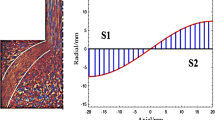Abstract
In this work, a flexible extrusion process which involves extruding the materials via one fixed and one movable die was studied. The novel extrusion process is termed as variable cross-section extrusion which can produce near net shape bars or tubes with variable cross sections along the length. During the extrusion process, the key is accurately and dynamically adjusting the geometry and size of die hole. Based on the “equivalent volume theory,” a novel motion control model was proposed for the movable dies. Besides, a numerical calculation method and a program for the model were also presented. By using the program, the motion parameters of movable dies were calculated for extruding a typical variable cross section. Finite element method (FEM) simulation and experimental work were carried out to analyze the precision and accuracy of the control model. According to the simulation results, the shapes of extrusion parts agree well with the designed shape. However, the measured dimensions of the FEM extrusion part are always smaller than the designed curves with absolute deviation of 0.81 mm. According to the experimental results, the dimensional tolerances are 0.35 and −0.22 mm when the movable die is moving upward and downward, respectively. These-dimensional tolerances are associated with the instant transformation of moving direction of the movable die, which were driven and controlled by an electrohydraulic servo system. All results have shown the motion control model has enough precision and accuracy and can be used in the processes of design and parameter calculation.
Similar content being viewed by others
References
Shiraishi M, Nikawa M, Yamaguchi M (1999) Flexible extrusion with inclined dies to control metal flow. Journal of the Japan Society for Technology of Plasticity 40:683–685
Nikawa M, Shiraishi M, Miyajima Y, Horibe H, Goto Y (2002) Production of shaped tubes with various curvatures using extrusion process through inclined die aperture. Journal of the Japan Society for Technology of Plasticity 43:80–82
Shiraishi M, Nikawa M, Goto Y (2003) An investigation of the curvature of bars and tubes extruded through inclined dies. Int J Mach Tools Manuf 43(15):1571–1578. doi:10.1016/S0890-6955(03)00201-3
Shiraishi M, Nikawa M, Horibe H, Matsuo K, Goto Y (2005) Flexible extrusion system with control of die inclination angle for producing elongated parts with successively varied curvatures. Journal of the Japan Society for Technology of Plasticity 46:874–878
Zaikovsky VB, Kutuzov JP, Zakharov MF, Kavtaev EE, Poedinschikov JG, Bazhanov JM, Schapov VA (1977) Die for extruding articles with variable cross-section profile. US, US4050288.
Takikawa K (1996) Long deformed extruded metallic shape and method for manufacturing said shape. US, US5557962.
Kato M, Sano S, Hiyoshi Y (1999) Variable section extrusion die set and variable extrusion molding method. US, US5989466.
Makiyama T, Murata M (2005) A technical note on the development of prototype CNC variable vertical section extrusion machine. J Mater Process Technol 159(1):139–144. doi:10.1016/j.jmatprotec.2004.04.389
Selvaggio A, Haase M, Khalifa NB, Tekkaya AE (2014) Extrusion of profiles with variable wall thickness. Procedia Cirp 18(18):15–20. doi:10.1016/j.procir.2014.06.100
Tekkaya AE, Selvaggio A, Khalifa NB, Chatti S (2012) Manufacture of profiles with variable cross-sections, curvatures and twistings by influencing the material flow in hot extrusion. Steel Res. Int.:507–510.
Zhang C, Zhao G, Chen H, Guan Y, Kou F (2011) Numerical simulation and metal flow analysis of hot extrusion process for a complex hollow aluminum profile. Int J Adv Manuf Technol 60(1–4):101–111. doi:10.1007/s00170-011-3609-7
Sharififar M, Mousavi SAAA (2015) Simulation and optimization of hot extrusion process to produce rectangular waveguides. Int J Adv Manuf Technol 79(9–12):1–13. doi:10.1007/s00170-015-6950-4
Xia X, Chen Q, Huang S, Lin J, Hu C, Zhao Z (2015) Hot deformation behavior of extruded Mg–Zn–Y–Zr alloy. J Alloy Compd 644:308–316. doi:10.1016/j.jallcom.2015.04.217
Author information
Authors and Affiliations
Corresponding author
Rights and permissions
About this article
Cite this article
Jun, L., Xiangsheng, X. & Qiang, C. An investigation of the variable cross-section extrusion process. Int J Adv Manuf Technol 91, 453–461 (2017). https://doi.org/10.1007/s00170-016-9710-1
Received:
Accepted:
Published:
Issue Date:
DOI: https://doi.org/10.1007/s00170-016-9710-1



